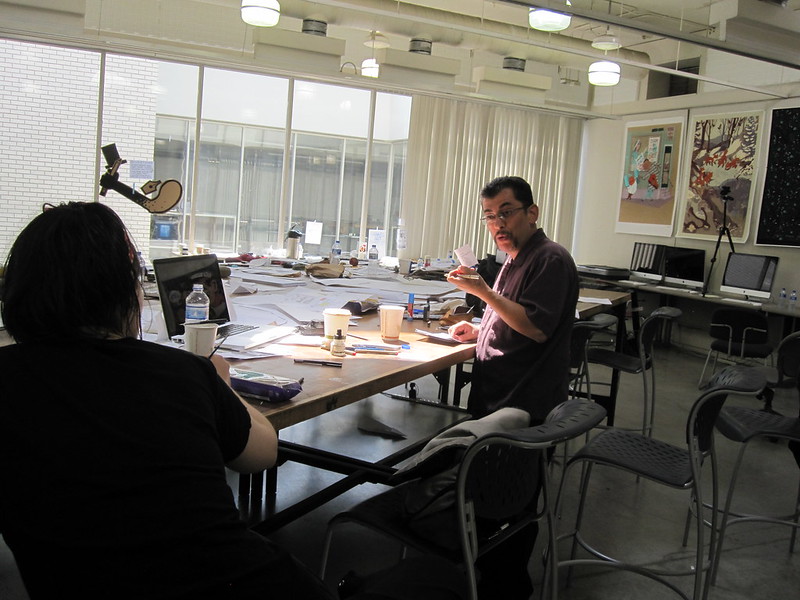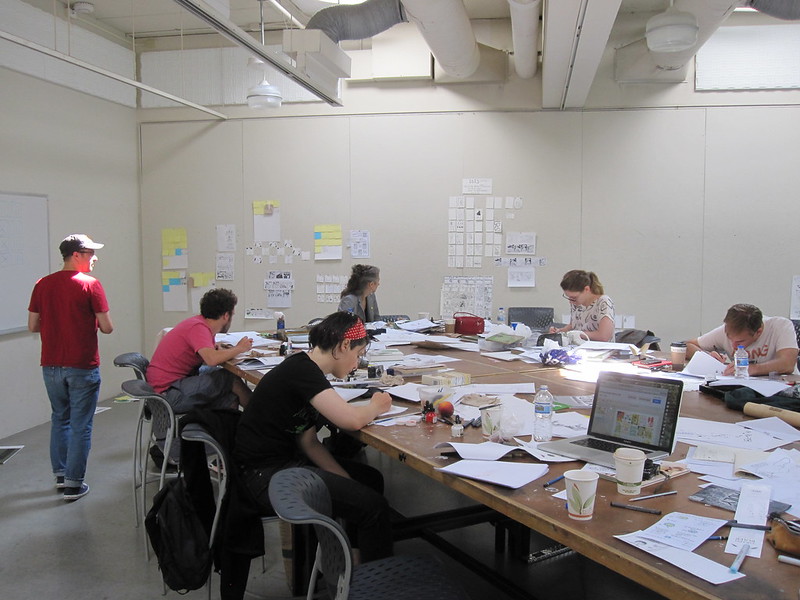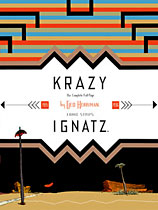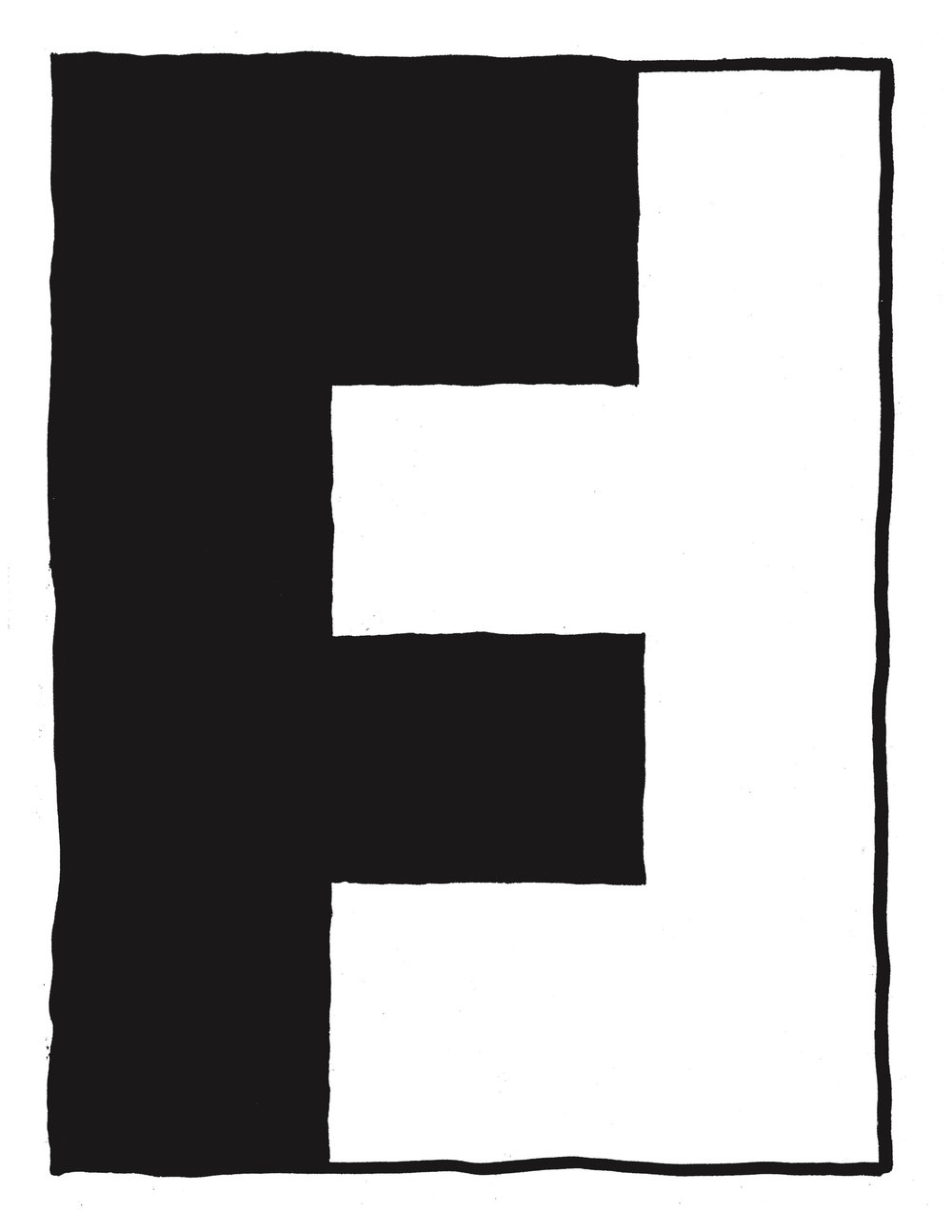-
Inept Doodles & De-Skilled Drawing
Bill Griffith doing comics criticism.
Do It Yourself Thoughts
At first, you learn: OK, a different guy wrote this than drew it. This made sense to you on one level, but on another level you had read the story as a portal to another world, naively, as one thing. You look at the credits.
The guys (more than one!) who drew it, colored it, they were credited as “pencils, inks, colors” etc. in that order. A different guy put the words in the word balloons? He wrote the words by hand, that was his whole job?! This was a production team, which must have necessitated a certain amount of coordination. That must be the editor? OK, so this is how comic books are made!
Then you learn that even though this method seemed to be how many, many (most?) of the comic books were made, sometimes one guy does the whole thing! Or like one guy with a little help. Or like one guy but then someone else takes care of all of the publishing stuff. You realize you hardly know anything about how publishing works. You picture giant printing machines like the ones that make newspapers in old movies. But some comics it’s one guy who does all of the work, including the publishing stuff, what otherwise in most comic books takes a team of like 5-10 people!. That seems crazy but also kind of cool, maybe. Simple and all the money goes to one person (you). Who figures out how the money gets divvied up on comic books? What a strange math equation that must be. Makes your head spin! So ignore the money stuff for now, and just think to yourself, Can I do all of those things? Sure, how hard can it be?
Glossary:
DIY = Do It Yourself
NYDI = No, You Do It (Jesse Reklaw.) AKA division of labor (doing). Normal
DIHTDEAH = Do I have to do everything around here
Good Writing
"Simply put, my career in comics was not an enjoyable one, nor one that I can look back on with any fondness, sense of genuine accomplishment, or indeed anything except for a wearying depression at having wasted so much of my life in an industry that is, to me, an embarrassment."
-Alan Moore, 2020
Wolverine vs. Silver Surfer (2010)
PFC

Jaime Hernandez and Genevieve Castree at Pierre Feuille Ciseaux, held at the Minneapolis College of Art and Design (MCAD) in 2013.

PFC.
2017 Time Capsule
The Industry
My Career in Comics 2
Barogque
7/7/1015 - Baroque 1
7/3/15 - Notes on Method - Comics / Typography
"...I think you should try thinking about clarity[...]A crucial place to focus is on your lettering. In your sketchbooks, copy typography that appeals to you, and approach your cartooning the way good typography is designed, balancing positive and negative spaces so that your panels "read" quickly and clearly. Cartooning can be thought of as graphic design, and as a typography of icons, or maybe just as having good handwriting, if your handwriting also includes a system of complicated emojis. In your sketchbooks try developing your own fonts—nothing fancy, just letterforms you like—and then play around with using them in non-sequiturs and to say offensive things, whatever gives them energy and keeps it interesting. Create your own "fonts" of imagery too–instead of drawing a character from scratch each time, create a system in which you limit poses and character sizes to a only a few standard sizes and views, then trace those into panels before customizing the figure to whatever the needs are of that particular moment in the story (e.g., Bushmiller, Neil Jam, Segar, etc.). Another recommendation is to use graph paper (e.g., G. Bell), or (I prefer this–>) paper with dots in a grid pattern (link). This will keep you on track with at least the horizontal and vertical lines. Grids are very important for clarity..."
"...the greatest cartoonists often have their own individual "feel" for typography, their own "font suitcases." When we think of the great cartoonist X we can also usually think of what is [X]-ian, their style or aesthetic that includes more than just the comics—there's also the "types" of typography they tend to use, a sense of design ..."
"...a general rule to remember is that if your hand-writing is difficult to read, your cartooning is probably difficult to read. Experiment with shrinking and enlarging your panels to get a sense of what size is ideal for legibility in different contexts..."
0 1 2 3 4 5 6 7 8 9
A B C D E F G H I J K L M N O P Q R S T U V W X Y Z
a b c d e f g h i j k l m n o p q r s t u v w x y z
, . … : ; ? ¿! ¡ # $ & @ ¤ ¢ £ ® © ™ % ‰ * + - – — _ = ~ ∞
( ) < > [ ] { } “ ” ‹ › / \ “ ” „ ‘ ’ " '
.

Wild Animals I Have Known

I was looking for some good scans of
Wild Animals I Have Known
on the web, but the only one I could find wasn't very good, so I started scanning my copy and will be putting those
. I only have a few up now, but I'll let you know when there's more. (If you know of some good scans online please let me know.) This is a pretty great comic book drawn by LB Cole, and the inks still look great in my copy. There's something lost in the scans, though, because the way the dot patterns look on the screen doesn't match the way they look on the paper, but
look better than others I could find.
When I post more pages, I'll let you know.
If you scroll all the way to the right there's a "NEXT" in the bottom right corner that will take you to the next set of pages. And I could just post the links here:
Also, if the pages are too big on your screen, you can hold down "command" and press "-" (minus sign) (on a Mac) until you're happy, or hold down "CTRL" and press "-" (on a PC (I think?)). Doing the same with the plus sign will make them bigger.
Heroes and Villains
 From Bill Blackbeard's introduction to Krazy & Ignatz 1935-1936: "A Wild Warmth of Chromatic Gravy":
From Bill Blackbeard's introduction to Krazy & Ignatz 1935-1936: "A Wild Warmth of Chromatic Gravy":"There are just over four hundred and fifty of them, and each one a masterpiece of graphic comedy. The marvelous product of the last nine years of Garge's richly fruitful life, these weekly color Krazy Kat pages, stunning as they are, almost failed to physically survive the editorial and institutional rigors of their time. We are, in fact, damned lucky to have them on hand at all as source material for this series. There were, you see, just two newspapers -- six day a week sports and crime news afternoon newspapers, throwaway rubbish -- that printed virtually all of the color Kat pages from start to finish. Neither the New York Journal nor the Chicago American, sensational Hearst papers, had anyreferential status at all, and most libraries in their sales areas shunned them -- two papers that virtually no one of any artistic or literary taste and judgment ever saw fro mthe the strip's 1935 start to its 1944 conclusion. Two tombs for the foremost comic strip of all time.
Luckily there was a single dedicated comic strip buff, August Derleth of Sauk City Wisconsin, founder of Arkham House in 1939, who clipped and saved every color Kat page, donating his run to the Wisconsin State Historical Society..."
This floored me! Has someone put up a statue of August Derleth!? What a hero! (See more here.)
Reading this I immediately got up from the couch and called the STL Public Library and ordered that book by Nicholson Baker, which I've always meant to read: Double Fold: Libraries and the Assault on Paper.

I'm near the end of Double Fold now. Read it if you're like me and you're a bibliophile, library lover, or if it gives you bitter yet invigorating pleasure to read histories of human folly, hubris, and tragedy. I wish there was a Library of Congress Subject Heading for these sorts of books. Marvel at how libraries threw out tons of old newspapers and books after microfilming them, and now threaten to do the same in an age of scanning and Internet. Don't you hate microfilm? I also got out Baker's Book of Matches which I finished in bed in 3 nights, and I enjoyed that very much as well. I think Glenn would like it a lot.
Anyways, in the Preface, Baker writes:
"...a man named Blackbeard told a reporter that he had a story for me...Blackbeard had a formal, slightly breathless way of talking; he was obviously intelligent, perhaps a little Ancient Marinerian in the way that lifelongcollectors can be...Some of what Blackbeard told me I couldn't quite comprehend: that the Library of Congress, [esp. arch-villain Verner Clapp, pictured left -kh.] the purported library of last resort, had replaced most of its enormous collection of late-nineteenth and twentieth-century newspapers with microfilm, and that research libraries where relying on what he called "fraudulent" scientific studies when they justified the discarding of books and newspapers on the basis of diagnosed states of acidity and embrittlement.
...In 1967, filled with an ambition to write a history of the American comic strip, he'd discovered that libraries were getting rid of their newspaper collections...Unfortunately he was a private citizen--the library's charter permitted the transfer of material only to a non-profit organization. "I became a non-profit organization so fast you couldn't believe it," Blackbeard told me...He went around the country picking up newspaper volumes..."

So Blackbeard in addition to saving all those newspapers was largely the catalyst for Baker writing Double Fold. Though unfortunately library collections are still not safe from library futurists, Baker and other activists are working to preserve primary source materials--books and newspapers. Double Fold makes a very powerful case and is probably responsible for a lot of eye-opening and hesitation on the part of librarians blinded by technology.
It struck me, thinking about all this, of how much comics have meant for newspapers, back in the day when they helped sell them, and (via Blackbeard) they've helped save them, and how sad that this relationship has been left to wither as much as it has.
UPDATE: There's lots more about Double Fold all over the web, with librarians, archivists, and preservationists responding, for instance here. Like every complex problem that gets people passionate, there's a lot of missing the point going on, but it's always worth getting a wide view of things. Related to this, one of the weird sidelights in the book, a chapter on how mummies were used by the ton as fuel for trains and their wrappings used in linen paper turns out to be untrue. So reader beware.


















